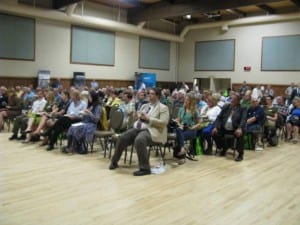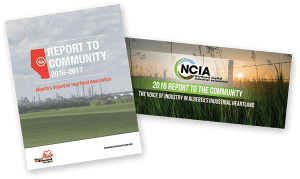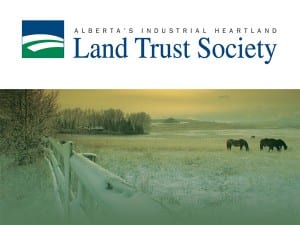Newsletter: Spring 2017
[cs_content][cs_section parallax=”false” separator_top_type=”none” separator_top_height=”50px” separator_top_inset=”0px” separator_top_angle_point=”50″ separator_bottom_type=”none” separator_bottom_height=”50px” separator_bottom_inset=”0px” separator_bottom_angle_point=”50″ style=”margin: 0px;padding: 0px;”][cs_row inner_container=”false” marginless_columns=”false” style=”margin: 0px auto;padding: 0px;”][cs_column bg_color=”rgb(240, 240, 240)” fade=”false” fade_animation=”in” fade_animation_offset=”45px” fade_duration=”750″ type=”1/1″ style=”padding: 20px;border-style: solid;border-width: 1px;border-color: hsl(0, 0%, 0%);margin-bottom: 20px;”][cs_text]
Heartland Community Information Evening
 Wednesday, April 12
Wednesday, April 12
Moyer Recreation Centre in Josephburg
Doors open at 5:00 PM
Presentations begin at 6:00 PM
Join us for an information update with businesses and industry-related organizations within Alberta’s Industrial Heartland and surrounding region. Hear about current industrial projects, activities, and plans. For planning purposes, please [x_button shape=”square” size=”mini” float=”none” href=”https://www.surveymonkey.com/r/InfoEveSpring2017RSVP” target=”blank” info=”none” info_place=”top” info_trigger=”hover”]RSVP online[/x_button] or call/text 780.231.9802.[/cs_text][/cs_column][/cs_row][cs_row inner_container=”false” marginless_columns=”false” style=”margin: 0px auto;padding: 0px;”][cs_column bg_color=”rgb(25, 117, 113)” fade=”false” fade_animation=”in” fade_animation_offset=”45px” fade_duration=”750″ type=”1/2″ style=”padding: 20px;”][cs_text style=”color: #ffffff;”]
Fort Air Partnership Annual General Meeting
Monday, May 8
Lions Room, Dow Centennial Centre, Fort Saskatchewan
6:00 – 9:00 PM
Meeting begins at 6:15 PM
Food and refreshments will be served. For planning purposes, please RSVP to info@fortmail.org or call 1-800-718-0471.[/cs_text][/cs_column][cs_column bg_color=”#d3a245″ fade=”false” fade_animation=”in” fade_animation_offset=”45px” fade_duration=”750″ type=”1/2″ style=”padding: 20px;color: #222;”][cs_text]
Fort Saskatchewan Trade Fair
April 21 – 23
Dow Centennial Centre
Be sure to grab one of our popular bright green reusable shopping bags and fridge notepads that will be available for trade show goers (until supplies run out). Note that instead of having a booth this year, we’ve decided to sponsor the vendor breakfast. We look forward to hosting that breakfast and chatting with vendors to kick off Saturday morning at the trade show.[/cs_text][/cs_column][/cs_row][cs_row inner_container=”false” marginless_columns=”false” style=”margin: 0px auto;padding: 0px;”][cs_column fade=”false” fade_animation=”in” fade_animation_offset=”45px” fade_duration=”750″ type=”1/1″ style=”padding: 0px;”][cs_text]
Local Air Monitoring Network Undergoing Changes

A portable air monitoring station like this one will be added to FAP’s network this year.
The air monitoring network in and around Alberta’s Industrial Heartland is undergoing some important changes this year. The network itself, overseen by Fort Air Partnership (FAP), will be bolstered this fall by the addition of a portable continuous air monitoring station. This station will move around the airshed, staying several months in one place, to monitor air quality in areas previously underserved by FAP’s nine fixed-in-place continuous
monitoring stations.
Also in 2017, a fixed continuous air monitoring station will be relocated closer to the Town of Redwater. This move will allow monitoring of ambient air quality where people live, a primary monitoring objective for FAP’s regional network. Currently, the station is next door to industrial facilities several kilometres south of Redwater. Known as fence line monitoring, the data currently collected is very localized and does not provide an accurate picture of regional air quality.
Thanks to additional funding, FAP is also moving forward with three important projects this year. These projects include:
- Completion of a Volatile Organic Compound Air Sampling Study at Bruderheim. This study will provide a better understanding of the impact of all emissions on regional air quality, including smaller sources such as oil and gas wells.
- A three year Particulate Matter Speciation program in Fort Saskatchewan. While FAP already monitors particulate matter concentrations throughout the region, this program will provide more detailed information on what these particles consist of.
- Customized reporting that will summarize several years’ worth of air monitoring data into a colour-coded diagram. This will provide an illustration of the trends and seasonal variability of some of the substances monitored by FAP.
In January, FAP removed sulphur dioxide and ammonia analyzers from its continuous monitoring station located on Range Road 220, about one kilometre north of Highway 15.
The move, approved by Alberta Environment and Parks, was made because the analyzers at that station were providing redundant information. Also, the local industrial operations and conditions that originally required these analyzers at this station no longer exist.
“Local residents will not be affected by this change as we have other stations nearby to measure and provide information on the amount of airborne sulphur dioxide and ammonia. We will continue to have a good understanding regionally of these substances in the ambient air,” explained Nadine Blaney, FAP’s Executive Director.[/cs_text][/cs_column][/cs_row][cs_row inner_container=”false” marginless_columns=”false” style=”margin: 0px auto;padding: 0px;”][cs_column fade=”false” fade_animation=”in” fade_animation_offset=”45px” fade_duration=”750″ type=”1/1″ style=”padding: 0px 0px 20px;”][cs_text]
Corporate Community Investment Changes Lives

Jesse Hatley (far left) and Jerome Wong (far right) are two of many Dow Chemical employees who volunteer their time to mentor high school FIRST Robotics teams in Fort Saskatchewan. Featured here is the Sting team from Fort Saskatchewan High School.
At one of the local schools, a group of high school students was in the midst of building an industrial sized robot to compete against other teams in the FIRST Robotics challenge. With limited resources, a six week time limit and strict rules, the team harnessed the engineering knowledge and creativity from their student members and adult mentor.
This particular team’s lead programmer was a student who previously struggled in the classroom and had yet to find his niche on the academic front. It was this program that helped spark a new interest in learning and consider a STEM (Science, Technology, Engineering and Mathematics) career path.
Success stories like this, and programs like FIRST Robotics, are highlights of Dow Chemical Canada’s community investment. It can be tricky for non-profits, sports teams and clubs to run on small budgets. It is also a challenge for schools and post-secondary institutions to afford all the tools, materials and programs that could benefit students.
That’s where a company like Dow comes in. Many of the major industrial companies in Alberta’s Industrial Heartland like Dow have extensive and unique community investment activities. They recognize the benefit of having a positive impact on the community in which they operate. This approach has led to Dow’s investment over the past decade in the Heartland region that is valued well into the millions of dollars. “It is truly about the impact and not about the funding,” commented Shawna Bruce, Public Affairs Manager for Dow Canada. “We keep our finger on the pulse of our operating communities to determine the needs and invest appropriately to meet them.”
If your organization or cause is looking for involvement from local industry, visit the Community Investment page. You will find links to details and applications for community investment programs sponsored by companies. The deadlines occur at various times throughout the year, so be sure to check back often for the most up-to-date information.[/cs_text][/cs_column][/cs_row][cs_row inner_container=”false” marginless_columns=”false” style=”margin: 0px auto;padding: 0px;”][cs_column fade=”false” fade_animation=”in” fade_animation_offset=”45px” fade_duration=”750″ type=”1/1″ style=”padding: 0px;”][cs_text style=”margin-bottom: 20px;”]
Heartland Outlook: Three Major Projects Highlighted
[/cs_text][x_image type=”none” src=” ” alt=”” link=”false” href=”#” title=”” target=”” info=”none” info_place=”top” info_trigger=”hover” info_content=””][x_columnize]Alberta’s Industrial Heartland is an important economic engine for the province and country. With approximately $35 billion in capital investment, over 6,000 full time employees, and over $1.5 billion annual spending on goods and services, the region continues to be a hub of activity.
” alt=”” link=”false” href=”#” title=”” target=”” info=”none” info_place=”top” info_trigger=”hover” info_content=””][x_columnize]Alberta’s Industrial Heartland is an important economic engine for the province and country. With approximately $35 billion in capital investment, over 6,000 full time employees, and over $1.5 billion annual spending on goods and services, the region continues to be a hub of activity.
There are many regions around the world that have established industry clusters, like the United States Gulf Coast, Saudi Arabia, and Europe. But with low cost feedstock, like propane, the Heartland continues to draw interest from global investors. Companies are attracted to Alberta’s Industrial Heartland as a result of this feedstock, and also the developed transportation infrastructure, stable government, low taxes, and skilled labour in the region.
There are several major projects recently completed or currently under construction. Here’s a look at three of them.
Two Propane Processing Facilities
Inter Pipeline Limited (formerly Williams Energy Canada) and Pembina Pipeline Corporation have plans for propane dehydrogenation (PDH) facilities to convert propane to propylene. The propylene would then be further processed into polypropylene, a product worth six to eight times more than propane. Since propane prices are at historical lows, it makes sense to obtain more value out of this resource by processing it into a higher value product before shipping it to markets around the globe.
These two facilities would be the first of their kind in Canada. The combined capital cost is expected to reach approximately $6 billion. With facilities of this size, this will result in local spending on goods and services in addition to taxation for local municipalities. Employment from the projects combined will reach 4,000+ construction jobs and nearly 250 operational jobs. Some of this employment and spending will be spread across the province with suppliers and service companies, engineering firms, fabrication yards, and more.
Both companies anticipate their projects to be in service in 2021.
One Power Generating Station
ATCO Power has plans to build and operate a natural gas-fired power station called the ATCO Heartland Generating Station. The station will use clean and efficient natural gas-fired combined-cycle technology. This means that natural gas will be used to produce electricity and heat. The heat is then converted to steam and that steam is used to produce additional electricity. Once complete, the facility will produce enough electricity for approximately 400,000 homes in Alberta. ATCO indicates that construction will start at the end of 2018, with full commercial operation scheduled to begin in 2022.
Stay Informed About Future Projects
To learn more about the location, details, and timeline for industrial projects in Alberta’s Industrial Heartland go to the Project Status page. A listing of many of the major projects that are planned or currently under construction can be found there.[/x_columnize][/cs_column][/cs_row][cs_row inner_container=”false” marginless_columns=”false” style=”margin: 0px auto 20px;padding: 0px;”][cs_column fade=”false” fade_animation=”in” fade_animation_offset=”45px” fade_duration=”750″ type=”1/3″ style=”padding: 20px;border-style: solid;border-width: 1px;”][cs_text]
Community Reports
 Community reports from Alberta’s Industrial Heartland Association and Northeast Capital Industrial Association have recently been released. The reports provide 2016 highlights, statistics and features of interest to local residents and other stakeholders. Go to industrialheartland.com and ncia.ab.ca to view the reports.[/cs_text][/cs_column][cs_column bg_color=”rgb(25, 117, 113)” fade=”false” fade_animation=”in” fade_animation_offset=”45px” fade_duration=”750″ type=”2/3″ style=”padding: 20px;color: #fff;”][cs_text]
Community reports from Alberta’s Industrial Heartland Association and Northeast Capital Industrial Association have recently been released. The reports provide 2016 highlights, statistics and features of interest to local residents and other stakeholders. Go to industrialheartland.com and ncia.ab.ca to view the reports.[/cs_text][/cs_column][cs_column bg_color=”rgb(25, 117, 113)” fade=”false” fade_animation=”in” fade_animation_offset=”45px” fade_duration=”750″ type=”2/3″ style=”padding: 20px;color: #fff;”][cs_text]
Alberta’s Industrial Heartland Land Trust Society Dissolved
 The Alberta’s Industrial Heartland Land Trust Society was created to operate the Voluntary Residential Property Purchase Program. The program was designed to acquire property from residential landowners residing in close proximity to heavy industry in the designated area of Alberta’s Industrial Heartland. As a result of this program, most residents living in close proximity to heavy industry who were interested in moving have been relocated.
The Alberta’s Industrial Heartland Land Trust Society was created to operate the Voluntary Residential Property Purchase Program. The program was designed to acquire property from residential landowners residing in close proximity to heavy industry in the designated area of Alberta’s Industrial Heartland. As a result of this program, most residents living in close proximity to heavy industry who were interested in moving have been relocated.
During the past few years, the Land Trust’s capacity to relocate residents was impacted by limited new industrial growth. The Board of Directors of the Land Trust Society determined that the objectives of the Society have been substantially met and voted to dissolve at the end of 2016. All remaining funds have been distributed within the region, in accordance with the bylaws, to initiatives that will help address the quality of life of local communities.[/cs_text][/cs_column][/cs_row][cs_row inner_container=”false” marginless_columns=”false” style=”margin: 0px auto;padding: 0px;”][cs_column bg_color=”hsl(0, 0%, 94%)” fade=”false” fade_animation=”in” fade_animation_offset=”45px” fade_duration=”750″ type=”1/1″ style=”padding: 20px;border-style: solid;border-width: 1px;”][cs_text]
Public Board Members Wanted
 Interested in having direct input into the monitoring and reporting of air quality in your community? Then consider joining Fort Air Partnership’s Board of Directors as a public member. Visit fortair.org or contact Executive Director Nadine Blaney at info@fortairmail.org or 1-800-718-0471.[/cs_text][/cs_column][/cs_row][cs_row inner_container=”false” marginless_columns=”false” style=”margin: 0px auto;padding: 0px;”][cs_column fade=”false” fade_animation=”in” fade_animation_offset=”45px” fade_duration=”750″ type=”1/1″ style=”padding: 0px;”][cs_text]
Interested in having direct input into the monitoring and reporting of air quality in your community? Then consider joining Fort Air Partnership’s Board of Directors as a public member. Visit fortair.org or contact Executive Director Nadine Blaney at info@fortairmail.org or 1-800-718-0471.[/cs_text][/cs_column][/cs_row][cs_row inner_container=”false” marginless_columns=”false” style=”margin: 0px auto;padding: 0px;”][cs_column fade=”false” fade_animation=”in” fade_animation_offset=”45px” fade_duration=”750″ type=”1/1″ style=”padding: 0px;”][cs_text]
Renewing Industrial Operating Approvals
 Flipping through your local newspaper, you may notice ads from time to time about industrial companies renewing an Operating Approval. Just like the renewal of a driver’s license and passport are at set intervals, most industrial facilities must renew their Operating Approval every ten years.
Flipping through your local newspaper, you may notice ads from time to time about industrial companies renewing an Operating Approval. Just like the renewal of a driver’s license and passport are at set intervals, most industrial facilities must renew their Operating Approval every ten years.
Most facilities operating in Alberta’s Industrial Heartland need an approval to construct, operate and ultimately reclaim their site. This is required from the province of Alberta as one way to manage the environment. Once an approval is granted, a renewal is necessary every ten years. These regulations are part of the province’s Environmental Protection and Enhancement Act (EPEA).
Why renew?
Approval renewals are required for several reasons. In part, the renewal process allows the opportunity to review any changes to the facility, incorporate current environmental conditions and any additional requirements that have changed since the original operating approval was granted.
What is the process for renewing Operating Approvals?
Approval renewals are essentially treated like a new application. Companies must follow the Guide to Content for Industrial Approval Applications. This Guide describes all the information needed for the submission, including company and facility background, equipment, environmental conditions, public engagement, and more. Once completed, the application is submitted to Alberta Environment and Parks (AEP). The Alberta Energy Regulator (AER) has a similar process for these renewals.
Public involvement is a key component. The public must be notified of all applications through notices in local newspapers. Anyone that may be directly affected by an application may file a Statement of Concern with AEP or AER. All filed statements must be addressed by the applicant and the regulator prior to an approval or renewal being granted.
What can you expect in our region?
A number of facilities in Alberta’s Industrial Heartland will be going through the approval renewal process over the next year or two. Therefore, you are likely to see notices in local papers about those renewals. You can also stay informed using the Public Notice Viewers.[/cs_text][/cs_column][/cs_row][/cs_section][/cs_content]
